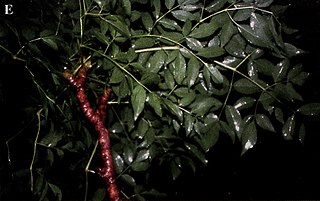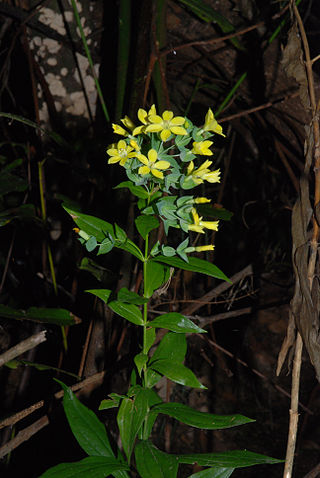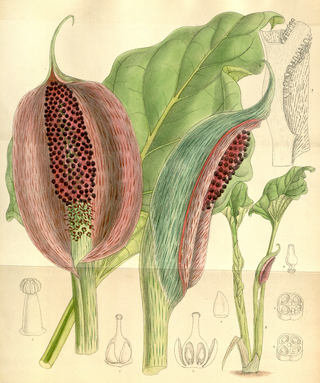
Plumeria, also known as frangipani, is a genus of flowering plants in the subfamily Rauvolfioideae, of the family Apocynaceae. Most species are deciduous shrubs or small trees. The species are native to the Neotropical realm, but are often grown as cosmopolitan ornamentals in tropical regions, especially in Hawaii, as well as hot desert climates in the Arabian Peninsula with proper irrigation.

Schinopsis lorentzii is a species of flowering plant in the family Anacardiaceae.

Aralia excelsa is a species of flowering plant in the family Araliaceae. It is native to Mexico, Central America, northern South America and parts of the Caribbean.
Carpodiptera is a genus of flowering plants in the family Malvaceae.
Athyana is a monospecific genus of plant in the family Sapindaceae, containing only Athyana weinmannifolia. It is found in Argentina and Bolivia. It is threatened by habitat loss.
Loxopterygium grisebachii is a species of plant in the family Anacardiaceae. It is found in Argentina and Bolivia. It is threatened by habitat loss.
Reynosia is a genus of plant in family Rhamnaceae. Darlingplum is a common name for this genus.
Tabernaemontana wullschlaegelii is a species of flowering plant in the family Apocynaceae. It is endemic to Jamaica.

Wallenia is a genus of flowering plants in the family Primulaceae endemic to the West Indies. It is composed of 29 species. It also includes a subgenus, Homowallenia, with ten species from the northern Caribbean.
Diacidia is a genus in the family Malpighiaceae. It comprises 11 species of trees, shrubs, and subshrubs. Ten species are found on the mountains of southern Venezuela and adjacent Brazil; one species is widespread in the drainages of the Rio Negro and the Río Vaupés in Venezuela, Colombia, and Brazil.
Glandonia is a genus of flowering plant in the family Malpighiaceae. It comprises 3 species of trees or shrubs native to lowland forests along rivers or in areas periodically flooded in Amazonian Colombia, Venezuela, and Brazil.
Blepharandra is a genus in the family Malpighiaceae. It comprises 6 species of trees and shrubs native to sandy savannas and scrub forests of Guyana, southern Venezuela, and Amazonian Brazil.
Coccothrinax rigida is a species of flowering plant in the family Arecaceae . It is a palm which is endemic to eastern Cuba.

Ixanthus is a monotypic plant genus in the family Gentianaceae. The sole species, Ixanthus viscosus, is endemic to Canary Islands laurel fields and displays small yellow flowers when in bloom.

Synandrospadix is a monotypic genus of flowering plants in the family Araceae. It comprises a single species Synandrospadix vermitoxicus. It is found in Peru, Argentina, Paraguay, and Bolivia. The inflorescence has an unpleasant smell with a spathe whose inner surface is purple with brownish-green warts and a smooth green outer surface. The spadix is egg shaped, red, and has spiked male flowers protruding from it.
Dicella is a genus of flowering plant in the familyMalpighiaceae. It includes seven species, assigned to two sections. Section Dicella comprises D. bracteosa and D. nucifera, found in southeastern Brazil and adjacent Paraguay and Argentina. Section Macropterys includes D. aciculifera, known only from Costa Rica, and D. conwayi, D. julianii, D. macroptera, and D. oliveirae, all of South America from Colombia south to about 19°S
Haenianthusis a genus of flowering plant in the family Oleaceae. It is native to the Greater Antilles of the Caribbean. It contains 3 species:
- Haenianthus incrassatus(Sw.) Griseb. - Jamaica
- Haenianthus salicifoliusGriseb. - Cuba, Hispaniola, Puerto Rico
- Haenianthus variifoliusUrb. - Cuba

Hemithrinax compacta is a species of flowering plant in the family Arecaceae. It is a palm that is endemic to Cuba.
Tetralix is a genus of flowering plant in the mallow family Malvaceae. It is native to Cuba. Members of the genus are adapted to serpentine soils, and are nickel hyperaccumulators.
Mionandra is a genus of flowering plants belonging to the family Malpighiaceae.







